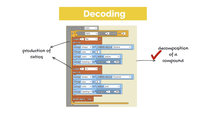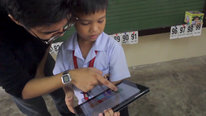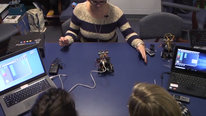- Jessica Smith
- Graduate Student
- A Study of the Curriculum Design for Integration of Middle School Mathematics and Computer Science
- https://csimms.cs.fsu.edu/
- Florida State University
- Ashley Gannon
- https://people.sc.fsu.edu/~ag12s/
- Graduate Student
- A Study of the Curriculum Design for Integration of Middle School Mathematics and Computer Science
- https://csimms.cs.fsu.edu/
- Florida State University
- Matt Mauntel
- Graduate Student
- A Study of the Curriculum Design for Integration of Middle School Mathematics and Computer Science
- https://csimms.cs.fsu.edu/
- Florida State University
Public Discussion
Continue the discussion of this presentation on the Multiplex. Go to Multiplex









Jack Broering
Your cookie example made if very clear on how to calculate the mean. How did your students do during your online classes with this concept?
Ashley Gannon
Graduate Student
Hi Jack! Thank you for your question. We received an overall positive response from teachers and students regarding the videos. However, due to COVID we do not currently have enough data to quantitatively measure learning gains for this module.
Ashley Gannon
Graduate Student
Hi everyone!
Our project focuses on integrating computer science in the teaching and learning of mathematics in middle school classes. Last year, we saw an increase in online learning due to COVID-19. Because most of our module tasks are motivated with interactive classroom activities, we needed to restructure them to fit this new online environment. In this video, we discuss how we modified the introductory task for our mean module to be taught online.
Thank you for taking the time to watch our video. We look forward to discussing it with you!
Aditi Wagh
Hi Jessica, Ashley and team! This sounds like an interesting project. I totally hear you about about how the pandemic threw a wrench in the vision for the kinds of activities that were possible to implement in online classrooms. In the activity example in the video, it wasn't clear to me how the approach was different from current approaches. So I'd love to hear more about what your vision for integrating CS and math looks like (in a non-COVID world)?
One of the reasons I ask is that my own project is about integrating CT in math and science learning. We're using decoding and modifying code as a way to support math and science learning. Take a look when you get a chance: https://stemforall2021.videohall.com/presentati.... Will be good to connect!
Jessica Smith
Graduate Student
Hi Aditi, thank you for your question! In this particular example, we embedded some videos that were not previously in the tasks. With online learning at some schools in our area, meeting for every class was not feasible for every student. With that in mind, we wanted to still try to provide a full learning opportunity to students by putting videos that either introduced or reviewed mathematics or computer science concepts.
I just watched your video and it would be great to connect! It looks like you have a bit more decoding, but we did put some decoding/debugging problems in our tasks, too!
Aditi Wagh
Thanks for responding! That makes sense. I'm sure the teachers appreciated the extra support and tailored materials. Yes, would be great to connect - I'm at awagh@mit.edu.
Allan Miller
I really like how your video breaks down the concepts and visualizes the solutions - seems really well thought out for your middle school students. I'm really curious how much of this is additional scaffolding that you might not take the time to create for in-person learning - or is the goal to have these be self-directed modules that could work both in person and virtually?
Jessica Smith
Graduate Student
Hi, Allan! That's a really great question. I would say that the videos are probably not a lot of added scaffolding but more toward the latter. Some of the students in the schools in our area are not able to attend classes online every day, so we wanted the modules in a state where they could be used by a full class and/or a single student. Before the pandemic, we didn't have any videos in the modules as we wanted to leave some freedom for teachers to add some of their own ideas while implementing them!
Sierra Morandi
Hi team, great job on this video! It's so nice to learn about the work you are all involved in. The cookie video seems to really break down the concepts and provides support for students during this online learning time. I'm curious to know if you think they'll be adjustments for implementation in face-to-face instruction and if so what those might look like? Thank you for this video and for sharing your work!
Jessica Smith
Graduate Student
Hi Sierra!! It's so good to hear from you. So, this video is actually highlighting changes we made because of the pandemic. The original design of the modules was done with face-to-face instruction in mind. I could see how some teachers might use ideas from these videos when they are back face-to-face again, though!
Sierra Morandi
Oh my gosh a total misunderstanding on my part, that's great and makes more sense in my mind now! The pandemic has brought on a whole new set of problems for our teachers and from your responses to other comments it seems like these videos are very helpful to both teachers and students!
Karen Mutch-Jones
Senior Researcher
Thank you for sharing your video and work--the cookie example was a nice way to quickly illustrate the ways in which you had to adapt and support students during this challenging year. And good to hear that you received positive responses from teachers and students. Did the teachers share descriptions of how they used these modules--were they provided after instruction as extra support or homework? Or were they used as introductory activities so that students could explore and talk (online) and then return to the class session and share and build off of the experience?
I'm sure you are eager to work in classrooms and interact with students in the future. Even so, does this experience encourage you to continue creating online activities for students as well? Did you notice specific benefits of the latter (I know the you weren't able to measure growth, just wondering if you observed something)?
I'm sure the teachers very much appreciated having these modules to support their online work. Thank you!
Matt Mauntel
Graduate Student
Thank you Karen for all of your questions. This year we collected interview data and video recordings of online classes from some of our teachers. We are still in the process of analyzing this data, but we hope to have something to report soon. For your second set of questions, I know several teachers mentioned that they thought the videos would be useful during class as a way for students to have information on demand. For example, we added some videos about programming commands in Scratch to the modules. Some of the teachers thought that this would allow students to look up a recap of the lesson presented in class as opposed to wait for the teacher to visit their group.
I cannot speak for other members of our research group, but the positive response from teachers encourages me to continue making videos for other projects when possible. I think the real challenge is making videos that are active learning experiences (which we tried to do by incorporating several pauses in the video for students to work on their own).
Karen Mutch-Jones
Senior Researcher
Thanks, Matthew for sharing more information about you research and possibilities for the future. I bet that online work will have a bigger role in the future, in conjunction with in school activities. Having high quality videos that support the work of both teachers and students will be needed--and this project has much to offer. Best wishes for data analysis and publishing your results!
Eric Pyle
Professor
Thank you for sharing the results of this work. I know middle school to be an ideal place for integrative curricula, and it is especially pleasing to see that this work is not "just one more thing" piled up on these teachers. But I have two main questions/challenges: (a) How do you convince teachers of the value-added proposition of participation and professional development, i.e. how do you convince them that this approach is any better than what they are already doing, and (b) how well would you anticipate student expectations for computational skills learning be supported in high school if their learning experiences are unaltered from the standard construct? I'm not trying to be confrontational, but these considerations are crucial to the long-term implementation and impact of a fine program as you have presented.
Ashley Gannon
Graduate Student
Hi, Eric! Thank you for your questions. To answer your first question, we did not try to convince teachers that implementing our modules would be 'better' than their usual instruction. The value teachers saw in our modules was in the computer science. They saw that students could learn math just as well with this implementation while also learning how to code. There are pros and cons to implementing our modules, like with any integrative and new curricula. From teacher interview data analysis, we found that a majority of teachers felt that the pros of this module implementation outweighed the cons and that this integrative approach is valuable.
For your second question, are you asking if we think we would see a decline in coding and computational skills if there is not a continuation of this work in high school? Possibly. However, the exposure to coding early in school can plant a seed for students to grow on. With our project, the intent was to plant this seed for more underserved students in computer science by implementing these modules in under-resourced schools. While it is true that these students might not be able to continue learning in this way through high school, we hope that the early exposure has motivated them to continue developing their skills on their own using free online resources or to continue learning after high school.
Eric Pyle
Professor
Ashley,
Thanks for your reply. For the first question, I am happy that you found a group of teachers willing to embrace this innovation without having to sell them on the idea. The elephant in the room, e.g. high-stakes testing, can in many cases serve as a barrier to innovation, rather than spurring it along. For the second question, I am not so worried about the loss of coding skills in high school, but rather the lack of perceived support or connection to mathematics by students when, having gained strong coding and computational skills in middle school, find them separated once again by the time they get to more advanced mathematics classes in high school.
Ryan Campos
👍🏻
Ashley Gannon